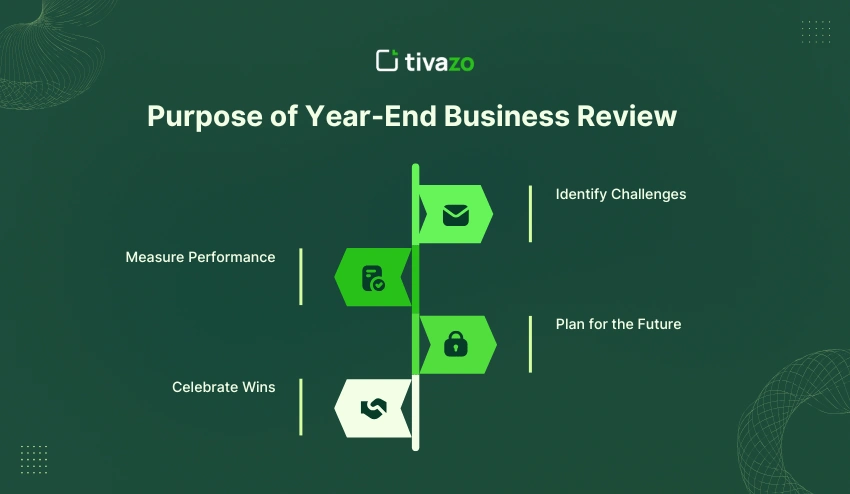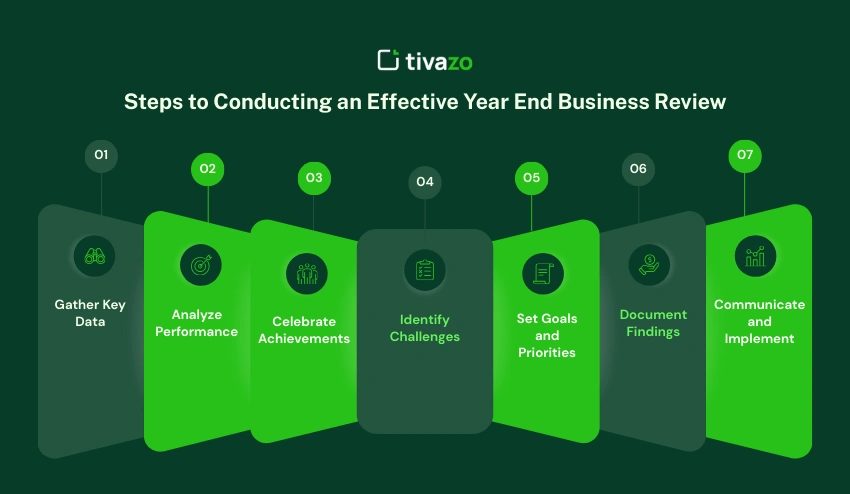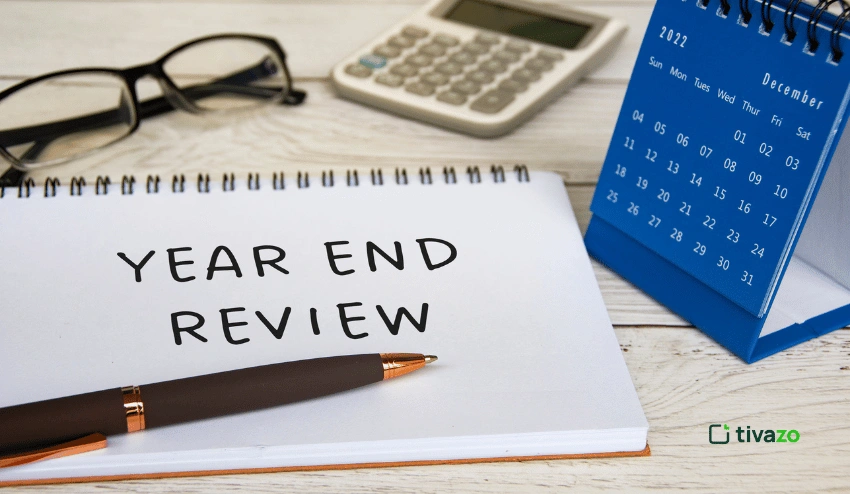The close of the year is not merely about closing the books, but it is a time to go over, re-establish, and set sights.
An inclusive year end business review can show you how much progress you have made, your wins and where you can make improvements. It is more than a financial summary; it is a strategic weapon of performance assessment, KPI analysis, and setting definite objectives for the next year.
A year end business review, when properly done, can offer you great insights into the way your business has performed in the last 12 months. It underscores the successes, identifies the opportunities overlooked, and makes informed decisions towards development. With the help of analytical numbers and knowledge gained, you can guide more effective strategies, enhance team cohesion, and develop practical action plans to use in the future. It does not matter whether you are about to write up an annual business review, evaluate your financial performance, or discover new avenues of growth; this process will make sure that your business begins a new year in clarity and confidence.
What is a year end business review?
A business review at the end of the year is a well-organized analysis of the overall business performance of your company in the last 12 months. It does not just summarize the financial report, but it breaks down to the key performance indicators (KPIs), efficiency in its operations, and achievement of strategic objectives.
This review is a roadmap and also a reflection. It brings out the achievements to rejoice over, issues that need to be corrected, and areas of growth in the future. The companies that use their annual business review to evaluate the performance of employees, the satisfaction of customers, and the effectiveness of the processes in supporting the company’s objectives.
With the help of year ending company analysis, you get a clear vision of what has been done right, what has not, and where to target your resources. The outcome is a realistic base to strategic planning, setting goals and decision-making in the coming year.
What is the purpose of year end business review?
A year end business review is not just another annual business report, but is a planned exercise that aims to review your progress, set priorities, as well as get your company ready to grow on a sustainable basis. By setting aside time to review the last year, you would be able to see the trends and the opportunities that you would have missed and establish a more formidable base in the coming year.
In the end, this process is aimed at assisting leaders and teams to make evidence-based decisions, share successes, and develop a clear action plan. You are certain that your business goes into the new year with a clear picture, confidence, and direction, with a comprehensive annual business review.

1. Measure Performance
Among the primary aims of a year end business review is to determine whether your company has achieved its objectives or not. Taking a look at KPIs, benchmarks, and financial performance helps you get to know where you have done more than expected and what you have to improve. This performance appraisal is not merely a numbers game, but rather it is about getting to see what approaches worked towards growth and what slowed you down.
Through the strengths and weaknesses, you can have actionable insights in the future. Through this performance review process, you would not repeat the same mistakes as previously made, and you would build upon the right initiatives. It is also useful in setting realistic goals that are within the resources and vision of your company.
👉You May Also Like: Business Growth: 7 Essential Strategies for Success
2. Celebrate Wins
An annual company analysis gives a chance to celebrate the achievements and successes made in the course of the year. Rewarding employees by rewarding their work, the project, or the growth of customers will help develop a culture of appreciation and morale. It is a necessary process of sustaining your team and keeping it focused on the company’s objectives.
Congratulating on victories also strengthens good plans and instills confidence in the future. You can boost team engagement and establish a more focused and inspirational beginning to the new year by pointing out what worked well.
3. Identify Challenges
The other important role of a year end business review is to identify the barriers that slowed down the development. This involves examination of financial losses, process inefficiency, or employee performance gaps. The ability to determine such challenges will give the clearance to take corrective actions and prevent the re-emergence of problems.
Instead of perceiving these struggles as failures, take them as a learning experience. Through adequate reflection, you are able to perfect the operations, enhance workflow, and position your business better to deal with future uncertainties.
4. Plan for the Future
Probably, strategic planning for the next year is the most crucial use of year end business review. Through post-mortem learning, establishment of quantifiable targets, and resource mapping, you develop a roadmap, which you use to make decisions and grow your business.
This proactive strategy will make sure that your business is not only responding to the situation, but it is also making the necessary preparations to take the opportunity. The year end review gives the framework to begin the new year in a great way, starting with setting goals to forecasting.
How To Create an Effective Year End Business Review
A good year end business review begins with the collection of the right data throughout your organization, in terms of financial reports, KPIs, employee performance rankings, and customer reviews. When the information has been gathered, do some analysis to determine patterns, highlight successes, and identify challenges that defined the year. To transform the insights into action, consider concentrating on the alignment with the long-term objectives of your company, establishing the priorities of the improvement, and defining the ways to develop in the near future.
Engaging key stakeholders will help capture a wide range of ideas, and recording your results in an annual report on the business review will provide a yardstick for your progress. When you reflect and plan ahead, you make the review a great roadmap that propels you to make better decisions and better performance next year.
The steps to be followed to ensure a good year end business review at the end of the year are further elaborated as under. Let’s dive in.
Steps to Conducting an Effective Year End Business Review
It is necessary to undertake an orderly process when conducting year end business review to make sure the learning gained is practical and valuable. Through effective steps, the business is able to review the performance, celebrate, and strategize the upcoming year.
At the culmination of this process, you will have a holistic view of what is successful in your company and what its challenges are, including a realistic road map of how to get there. Systematic approach transforms your annual business review into a business-driving tool that enables you to make smarter decisions and improve long-term business performance.

1. Gather Key Data
The initial process when conducting a year end business review is the gathering of all the data of the previous year. This involves financial statements, KPI reports, sales data, customer feedback, and employee performance measures. The correct and full information will give you the certainty of basing your analysis on actual insights and not on hypotheses.
After the collection of data, put it in a manner that brings out trends and patterns. Visual aids such as charts or dashboards can be used to decode complex information. Such an organized strategy enables leadership to realize quickly where they are doing well and where efforts are required.
Gathering the detailed information also preconditions the discussions with your team. It will offer a common vision of what has worked and what has not, and the process of the annual review of the business will become more inclusive and effective.
2. Analyze Performance
Once the data has been collected, the second step is to evaluate the performance of your company according to its objectives. An annual business performance review must evaluate KPIs, business efficiency, projects, and revenue achievements that will highlight successes and gaps.
Trend analysis to compare performance between departments or quarters over a time period. Seek trends that can be used to tell why some initiatives were successful and why others failed, and they will be learned during future planning.
The performance analysis can also be used in prioritizing strategic initiatives to be undertaken in the following year. With knowledge of where to provide the utmost benefit, the leadership will be able to direct resources and establish viable, achievable objectives.
3. Celebrate Achievements
The recognition of year end business wins is a very important aspect in a year end business review. Rewarding the achievements, be it the addition of sales points or a successful project, or an increase in customer satisfaction, enables positive behavioral reinforcement and strengthens morale.
Reward both group and individual performance by taking note of those who did their part in helping the company perform successfully. This not only serves as a motivational factor to employees but also as a form of accountability and involvement in the future.
Rewarding success also sets the background for future planning. In the next year, you can duplicate what worked in order to expand on the strengths, and that is achievable by identifying what worked well.
4. Identify Challenges
One of the most important reasons for a year end business review is to establish the problems that have slowed growth or performance. This can be in terms of financial constraints, inefficiency of the process, or a shortage in team skills and resources.
Analyze these obstacles in an objective manner using data and feedback to get an overview of the underlying causes. It is better not to blame people but rather to be able to identify areas of improvement and systemic problems.
Difficulties are met to develop solutions that can be applied in the future. It is through failures that companies can learn and therefore, make a better process, increase efficiency, and also align more resources with strategic goals.
5. Set Goals and Priorities
When making decisions on the next year, set the goals based on the year end business review after the accomplishments and challenges are established. Set specific goals, prioritize activities, and harmonize the roles of team members to make all people work towards similar results.

Get realistic and actionable goals based on what has been learned in the review. Have short-term goals and long-term strategic goals to use in decision-making.
Priorities also enable allocation of resources. The existence of a clear roadmap will mean that the company is ready to exploit opportunities and deal with possible risks within the next year.
6. Document Findings
An in-depth business review report is an annual report that contains the insights, decisions, and action plans that are generated in the course of the review. This record becomes a point of reference to gauge improvement and gauge success over time.
Included should be a summary of financial performance, key achievements, challenges, and future strategies, accompanied by visual charts to make it clear enough. Correct documentation guarantees transparency and interdependence between teams.
Accountability is also possible through documenting findings. The report can be used to monitor progress and the strategies employed by the teams to work on the long-term objectives of the company.
7. Communicate and Implement
The last part of year end business review would be to share insights and act to plan. Share the results with the key stakeholders, such as the leadership, departmental heads, and employees, in order to have them aligned and buy-in.
The review will help plan the strategies, improve the operations, and set the goals for the following year. Reporting of results in a clear way assists teams in establishing priorities and their contribution towards the accomplishment of the same.
The recommendations of the review are turned into results through their implementation. Through acting on your lessons learned, your company will be able to keep on improving and start the new year with momentum, focus, and clarity.
By taking these steps, you will be able to make sure that your annual business review is thorough, practical, and well-strategized. You can accumulate information, review the performance, celebrate the wins, discuss the challenges, and plan the future, and this results in a review that can make better decisions and prepare your business to have a successful year to come.
Conclusion
A year end business review, which you carry out at the end of a business year, is not just one more event in a year, and it is a strategic chance to think about the performance of your company, congratulate yourself, discuss underperformance, and persist in developing. A year end business review can be described as a systematic analysis of KPIs, financial outcomes, employee input, and customer reviews, which gives practical insights that would lead to smarter decision-making and ensure that teams are aligned with the long-term objectives.
This process takes time to complete, and when it is done well, it not only does it points out what worked and what did not work last year, but also provides a clear roadmap of where to go in the new year, having a business that is focused, confident, and propelled.




